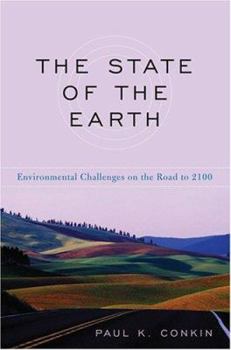The State of the Earth: Environmental Challenges on the Road to 2100
Select Format
Select Condition 
Book Overview
The pace of human progress accelerated profoundly in the twentieth century, spawning revolutionary advances in medicine, agriculture, and industry. Between 1900 and 2000, the world's population... This description may be from another edition of this product.
Format:Hardcover
Language:English
ISBN:0813124115
ISBN13:9780813124117
Release Date:December 2006
Publisher:University Press of Kentucky
Length:320 Pages
Weight:1.50 lbs.
Dimensions:1.1" x 6.3" x 9.3"
Customer Reviews
1 rating
Can the two-centuries-long banquet of the affluent nations continue without damaging the Earth's liv
Published by Thriftbooks.com User , 16 years ago
XXXXX "In this book...I hope I have offered...an understanding of the Earth and of life on Earth as to enable [readers] to understand the planet's vulnerability to human activities. I have tried to survey the road that lead to the major environmental issues that humans face today [and help readers better understand the challenges that lie ahead on the road to 2100]. I want to help people understand why we need to attend to these problems [or issues]...This is no easy task...[since] the literature on environmental issues is now...growing exponentially every year." The above is from the preface of this clear but not overly simplistic book by Paul K. Conkin, Professor Emeritus of History at Vanderbilt University and the author of numerous books. Conkin is absolutely correct when he says that it is no easy task to help readers understand how humans have come to the environmental crossroads they face today and what the future challenges hold. Has the author succeeded in his task? In my opinion, YES and he does it in a clear, thorough, historical & scientifically informed way. The book itself is divided into five parts. All parts (consisting of two chapters each) are interesting but I found parts three and four entitled "The Human Threat" and "Climate Change" respectively particularly interesting. As well, part five entitled "Environmental Policies and Philosophies" was quite informative. Books like this can be pontifical with the authors saying what should be done or that humans should do this or that. This book is different and for me, refreshing. It explains the realities and consequences of ecological disruption, unsustainable growth, and environmental degradation. It does not proclaim doom and gloom or suggest simply that new technologies or other free-market solutions will repair the damage that's already been done. Finally, this book is well illustrated. It contains almost twenty figures (in the form of graphs, charts, tables, etc.). I found all of these revealing and informative. In conclusion, this book, in my view, is the best assemblage of historical and scientific information about our ecological problems and about how humans have reacted (especially in the United States) that I have ever read. I leave you with the last two sentences of the book's excellent afterword: "Can the affluent rest at ease and continue to enjoy high living standards with the knowledge that there is not nearly enough resources for all humans to join the feast? And in such a world, how long will the affluent be safe at their banquet? (first published late 2006; preface; acknowledgements; 5 parts or 10 chapters; a personal afterword; main narrative 285 pages; notes; index) > <br /> <br />XXXXX <br />




